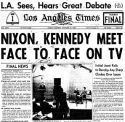 Now that the Fringe Fest is past, it is time to start clearing out the news chum (if I could just do that with the 70 backed up podcasts!). This first batch all provide some interesting histories:
Now that the Fringe Fest is past, it is time to start clearing out the news chum (if I could just do that with the 70 backed up podcasts!). This first batch all provide some interesting histories:
- Knitting as an Espionage Tool. This is an older article — I’ve been holding onto it for about a month. It tells the interesting story of spies that used knitting as an information hiding technique. Whether women knitted codes into fabric or used stereotypes of knitting women as a cover, there’s a history between knitting and espionage. When knitters used knitting to encode messages, the message was a form of steganography, a way to hide a message physically (which includes, for example, hiding morse code somewhere on a postcard, or digitally disguising one image within another). If the message must be low-tech, knitting is great for this; every knitted garment is made of different combinations of just two stitches: a knit stitch, which is smooth and looks like a “v”, and a purl stitch, which looks like a horizontal line or a little bump. By making a specific combination of knits and purls in a predetermined pattern, spies could pass on a custom piece of fabric and read the secret message, buried in the innocent warmth of a scarf or hat.
- Mr. Cellophane. In a previous post, I cited an article about the transformative nature of the elevator on society. Here’s another transformative item: cellophane. It changed the way we buy food by allowing clear packaging. Cellophane packaging let food vendors manipulate the appearance of foods by controlling the amount of moisture and oxygen that touched a product, thus preventing discoloration. In turn, it led to the rise of the self-service store. In a similar vein is plastic. We often think of gasoline and cars when we look at the impact of oil, but there’s an even bigger impact in oil-based plastic. Just imagine a world where there is no plastic. No plastic for food, gloves, medical equipment, insulation, packaging. It’s scary.
- Hawaiian Pizza. It seems simple doesn’t it: Canadian Bacon and Pineapple on a pizza. It’s heresy to some. But someone had to come up with the idea, and here’s the story of the invention of said pizza. You have tiki culture to thank. According to Atlas Obscura, the rise of tiki culture, as troops returning from the South Pacific after serving in World War II, and the influence of American Chinese food were crucial to inspiring the creator, who sought to unite the sweet and the savory — a mission that ended in him dumping a can of pineapple on a pizza pie.
- Yellow Cars. When you think of trolley cars and Los Angeles, I’m sure you think of the Red Cars — the cars made famous in Roger Rabbit — the cars that a “conspiracy” supposedly killed (truth: that’s an urban legend). But the Red Cars weren’t the only system. Here’s an article on LA’s narrow-gauge Yellow Car system. As opposed to the interurban Pacific Electric, the Los Angeles Railway provided quick, local service in downtown L.A. and nearby communities. For decades, the Yellow Cars’ bells rang as far west as La Brea Avenue and as far north as Eagle Rock, and the trolleys serviced neighborhoods from East Los Angeles to Hawthorne. Though their reach was shorter than that of the fabled Red Cars, the Yellow Cars carried roughly twice as many riders—at its peak in 1924, the Los Angeles Railway served 255.6 million passengers, and the Pacific Electric only 100.9 million.
- Beauty Remains. Yes, this is SFW. Here’s an interesting little bit of history, wherein Playboy cover girls recreate their iconic covers 30 or more so years on. Guess what? A beautiful woman remains beautiful.
- Boyle Heights. Lastly, there is currently an exhibition in the Boyle Heights neighborhood celebrating its Jewish history. I’ve been learning this history of late, and it is really fascinating — and it shows the impact of Yiddishists and Workers Movements on the Jewish Community of LA.

